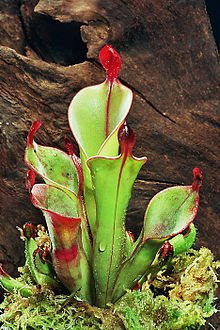Sarraceniaceae
| Sarraceniaceae Temporal range: Early Cretaceous – recent |
|
|---|---|
 |
|
| Heliamphora chimantensis | |
| Scientific classification | |
| Kingdom: | Plantae |
| (unranked): | Angiosperms |
| (unranked): | Eudicots |
| (unranked): | Asterids |
| Order: | Ericales |
| Family: |
Sarraceniaceae Dumort. |
| Genera | |
†?Archaeamphora
Darlingtonia
Heliamphora
Sarracenia
The Sarraceniaceae are a family of pitcher plants, belonging to order Ericales (previously Nepenthales).
The family comprises three extant genera: Sarracenia (North American pitcher plants), Darlingtonia (the cobra lily or California pitcher plant), and Heliamphora (sun pitchers). The extinct Archaeamphora longicervia may also belong to this family. All three are carnivorous plants that lure insects with nectar and use their elongated, tube-shaped leaves filled with water and digestive enzymes to catch and consume them. Digestive enzymes are not always produced by the plants themselves. Digestive mutualisms are common in Sarraceniaceae: both Sarracenia and Darlingtonia rely on commensal bacteria to supplement or produce all of their enzymes. Many species also use downward-pointing hairs and waxy secretions to make it difficult for insects to escape.
Sarracenia and Darlingtonia are native to North America, while Heliamphora is native to South America. Phylogenetic analysis suggests that the family originated in South America about 47 million years ago and spread to North America soon after, about 35 million years ago. The Sarracenia and Heliamphora clade diverged from Darlingtonia around this time, most likely due to a cooling event at the beginning of the Oligocene.Sarracenia diverged from Heliamphora later, around 23 million years ago.
...
Wikipedia
